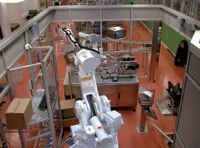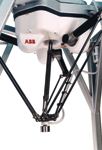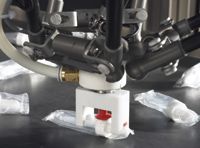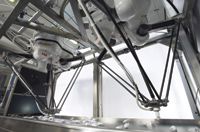Robots pack a punch
Pharmaceutical Technology Europe
Never has greater pressure been applied to pharmaceutical manufacturers. Shelf space competition for branded drugs has reached aggressive proportions and now even prescription drugs vie for pricing and delivery. Against this is a backdrop of ever-increasing downward price pressures, and a spectrum of progressively more stringent legislative and quality requirements. Finally, regional markets now demand different tamper evidence technology, anticounterfeiting measures and safeguards against interference by biological terrorists. Much of which points to the need for innovation in packaging - not just in terms of pack styles and sizes, but also cost.
Never has greater pressure been applied to pharmaceutical manufacturers. Shelf space competition for branded drugs has reached aggressive proportions and now even prescription drugs vie for pricing and delivery. Against this is a backdrop of ever-increasing downward price pressures, and a spectrum of progressively more stringent legislative and quality requirements. Finally, regional markets now demand different tamper evidence technology, anticounterfeiting measures and safeguards against interference by biological terrorists. Much of which points to the need for innovation in packaging — not just in terms of pack styles and sizes, but also cost.
Pressure and challenges
All pharmaceutical companies, whether they are large multinationals making branded products, producers of generics, contract manufacturers or co-packers, face the same downward price pressures. The industry has never been so competitive and, in spite of rising demand and emerging markets, costs remain a primary driver in manufacturing investment — particularly in packaging. Paradoxically, against these price pressures, the demand for quality, traceability, validation and tamper evident packaging all potentially conspire against the manufacturers that are trying to reduce costs.

Coupled with these factors, most pharmaceutical companies also face the challenge of increasing costs through to ongoing globalization, and the growing importance of product differentiation for primary and secondary packaging. This necessitates new levels of efficiency, cost-effectiveness and flexibility within the packaging process. In addition, packaging methods must be integrated within the entire supply chain — there has to be an interface with the preceding drug manufacturing steps, as well as the warehouse and distribution steps that follow.
Furthermore, the packaging must guarantee product stability within a specified time frame and ensure safe, secure storage and transport until final use. It must also satisfy its function as a marketing and communication device and, finally, there is the increased importance of patient convenience alongside child resistance, tamper evidence and protection against counterfeiting.

New packs with fresh challenges
New packaging styles and formats bring about fresh challenges for integration, system validation and security measures — including not just tamper evidence, but also patient information leaflets, and track and trace data (such as barcodes and RFID tags).
The net result of these pressures is that pharmaceutical companies must now carefully examine their production methods, costs and flexibility. Manufacturing processes are largely governed by the laws of chemistry and present few opportunities for savings achieved from efficiency or efficacy improvements. At the end of the line, however, there remains scope for investment that can yield dividends; not just in economies and cost reductions, but also by introducing commercial differentiators such as pack sizes, types and styles.

Key Points
Many analysts in the industry suggest there will never again be blockbuster drugs. Even if this sweeping statement is not entirely founded, it does highlight the unequivocal shift towards greater competition and variety in pharmaceutical products. Moreover, this is a trend that shows no sign of abating. To satisfy the changing market needs for variety and flexibility, the industry might perhaps look at its high volume, high variety counterparts in the food sector.
Customer-specific and innovative packaging designs are gaining importance, while the variety of products is increasing and batch sizes are shrinking. Hence, there is increasing demand for intelligent, versatile packaging systems that can handle a multiplicity of different products safely, quickly and cost-efficiently at the end of the production line.

Integration is a panacea
Modern packaging machinery can accommodate all sorts of programmable flexibility; in blister packing, wrapping, cartoning and secondary packing, but it is the handling and in-line quality control where challenges remain.
In addition to saving space and costs, robots can also ensure the required precision and reliability of packaging operations. Easy robot programmability is the key to enabling minimum resetting times when the plant is set to new products or packages, but also the combination of advanced software, diagnostics and modern machine vision systems can integrate the entire process through packaging lines. The benefits of a truly effective, amalgamative approach to automation are the overall reliability and profitability of the resultant system, and the ability for systems to share common control platforms. This enables electronic signaturing, foreshortened and cheaper validation because of common hardware and software platforms, simplified and cheaper maintenance, and even shared risk on the output and uptime of the lines.

Robots have been used in the packaging industry since the late 1970s, originally to handle heavy goods in the palletizing process. The pharmaceutical industry has been somewhat slower to react because the palletizing of bulky packages is rare. However, the use of robots in all types of packaging has now become established and they form the basis of more than 25000 units around the world. A wide range of different robots make up this figure, as they are used in many areas of packaging; from the handling of unpackaged goods, to the secondary packaging stage, right up to palletizing and transportation. In pharmaceuticals, they are largely restricted to feed placing, secondary handling, cartoning and, occasionally, palletizing.
Predominantly, robots are used to pack large numbers of small products into multi — or mixed — packs within a very short time, such as blister cards into cartons or onto conveyors for wrapping. Increasingly, products such as medical devices (e.g., inhalers and prefilled syringes) are packed using robots.
In the food industry, high-speed packaging lines have been developed for high volume output and many of the systems are capable of packaging several thousand products per minute. These speeds are rarely required by the pharmaceutical industry and linear high-speed systems are almost never needed at all for end-of-line packing, cartoning and palletizing. Flexibility, availability and reliable uptime efficiency are far more important.
For end-of-line-packing, the preferred choice is to adopt robot cell arrangements. In such a configuration, multiple axis — usually six-axis — machines perform a variety of flexible functions. These can include case or carton forming, as well as picking and placement of the products into the completed cases. Ancillaries, such as check weighers and packaging printing (e.g., barcoding) can be incorporated and located within the cell to consume minimal floor space. Indeed, the cell approach consumes significantly less floor space than a comparable linear packing line. Additionally, access to the ancillaries also makes maintenance or replacement of units quick and easy — an important consideration where availability of the system is key.
Getting to grips with robots
Some handling processes use SCARA or hexapod delta robots. Thanks to the compact dimensions of the delta kinematics, and the associated high speeds and acceleration properties, it is now possible to handle high numbers of products in confined spaces, in a very short time, and with relatively low energy requirements. Some of these robots have acceleration up to 10G with picking capabilities of more than 300 parts/min.
The fast handling speeds are down to the fact that in today's generation of robots, the control concept makes use of the very latest advances in computer processing speed. PC-based solutions, with their open architecture, have really made their mark.
Some applications use machine vision systems and image processing and, for more reliable operation, this can be directly incorporated into the motion controller of the robot. This comprehensive integration of all components into one platform facilitates efficient communication and guarantees reliable robot operation. Peripheral devices, which are used in large numbers in packaging systems, are also easily combined into a system through standard interfaces or field bus.
Users are now able to control robots via user-friendly programming interfaces, which have been simplified so that engineers familiar with programmable logic controls (PLCs) are also able to program robots. The user interface for every robot is a screen where it is easy to implement parameter changes during operation, which significantly increases the quality and efficiency of the system. Simple machine programming can also be used for new product shapes and sizes, as well as the possibility of viewing production statistics. Smaller operators are increasingly adopting this open technology, leading to a boom in the use of robots. There are also advantages when it comes to service and maintenance.
In many packaging lines, primary packaged products are usually discharged from the packaging process in a single track, before being passed on to the secondary packaging stage. This is often achieved manually or by using more conventional methods such as "side loading" or "wrap around" solutions. Conventional methods offer little flexibility and take up a great deal of space, while manual workers can be expensive. As a result, for both ergonomic and economic reasons, robotic systems are very much in demand in this area. The story is similar in secondary packaging, where the trend of replacing manual work with flexible robot systems continues unabated. Again, the use of six-axis machines brings enormous benefits in terms of the flexibility and capability to handle varying products — particularly when configured in cells rather than lines.
In both primary and secondary areas, replacing humans with robots can be a major cost consideration and robot suppliers should be conscious of supplying machines at acceptable price levels.
In a recent study conducted at a pharmaceutical manufacturing plant in the US, ABB calculated the labour costs for running a line with purely manual operation, using a traditional, commercially available case packer and a robotic solution. Taking into consideration changeover times, adjustment, downtime, testing samples, cleaning and visual inspection, the results showed a labour cost per shift of $4500 for a purely manual line, $1000 using case packing machinery and just $500 deploying a robot cell solution.
Handling of all sorts of products can be achieved using robots and there are many standardized solutions that can be incorporated into system concepts that extend the packaging process. Cartoning systems are predominantly offered with differing numbers of product infeeds, and the cartons can also be handled by the robots or fed in manually. With standardized carton sizes, the complexity of a system is limited and simple operation via a menu can be achieved. The flexibility of the robot is also high because it is possible to work with different gripper variants.
Invaluable technology
Robots possess many features that render them invaluable in pharmaceutical businesses. Robots have the ability to create greater pack variety and can integrate packaging processes. For instance, the simple inclusion of patient care leaflets poses an additional packaging need — especially if the information is market dependent and has in itself a number of variants. There is also the ability to package multiple packs — such as one blister card, two or more in varying pack sizes within a single line.
Some advanced systems enable the robots to automatically configure themselves according to preordained recipes, such as being able to change grippers as well as the motion programs, and, as the automation is secure, such arrangements simplify validation processes.
Robots can also be ideal for automatically compiling packs such as:
- Assembled packages, such as for wrapping inhalers with associated ancillaries and leaflets.
- Multipart drug treatments, for example, certain cold and flu remedies that have day and night time tablets.
- Some linctus products, including measuring spoons or cups within the carton.
In a recently installed end-of-line packing system for a Japanese manufacturer of inhalers, an expensive plastic case design could be replaced by a cheaper cardboard version because vacuum dust extraction was able to be incorporated within the robot cell. The robot was also programmed to apply a clear plastic label to identify if dust or particulate contamination was evident on the outside of the inhalers. Similarly, the cell was able to apply a tamper evident seal to the carton.
Validation issues
As part of an overall system, robotics technology complies with the stringent validation requirements of both GAMP and FDA 21 CFR Part 11. As robots, once programmed, are infallible, all that needs to be done to ensure compliance with validation is to have the customary software locks and electronic signatures, which are becoming commonplace with pharma process software.
Also, with flexible systems where perhaps several pack styles are produced on a single line, the individual programs can be similarly secured. All that then needs to be done is to ensure the correct grippers are fitted — a function that may easily fall outside validation requirements as it is unlikely to affect the process itself if an error were to be made.
The future
In the most futuristic setting, cartons will be transported automatically by wire or laser guided vehicles that are fitted with sensors that enable them to find their own way to the storage areas.
Robot technology means that it is now possible for a fully automated system to take a pharmaceutical product from the manufacturing process right through to the delivery point. Further development of the open control technology and existing robot mechanisms will lead to robots taking on ever more critical roles in systems of the future. Inflexible proprietary automation counterparts will be pushed further into the background and may possibly disappear completely from potential pharmaceutical applications.
Bengt Stom is the global segment manager pharmaceuticals for consumer industries at ABB's Robotics Division. His experience extends to working with global pharmaceutical giants through to small contract manufacturers and co-packers. He contributes input from the field to assist new product developments and then communicates those improvements locally and worldwide. He has worked in the packaging industry for many years, the past 11 of which with ABB. Prior to this, he worked for a packaging machinery manufacturer.
Drug Solutions Podcast: A Closer Look at mRNA in Oncology and Vaccines
April 30th 2024In this episode fo the Drug Solutions Podcast, etherna’s vice-president of Technology and Innovation, Stefaan De Koker, discusses the merits and challenges of using mRNA as the foundation for therapeutics in oncology as well as for vaccines.
